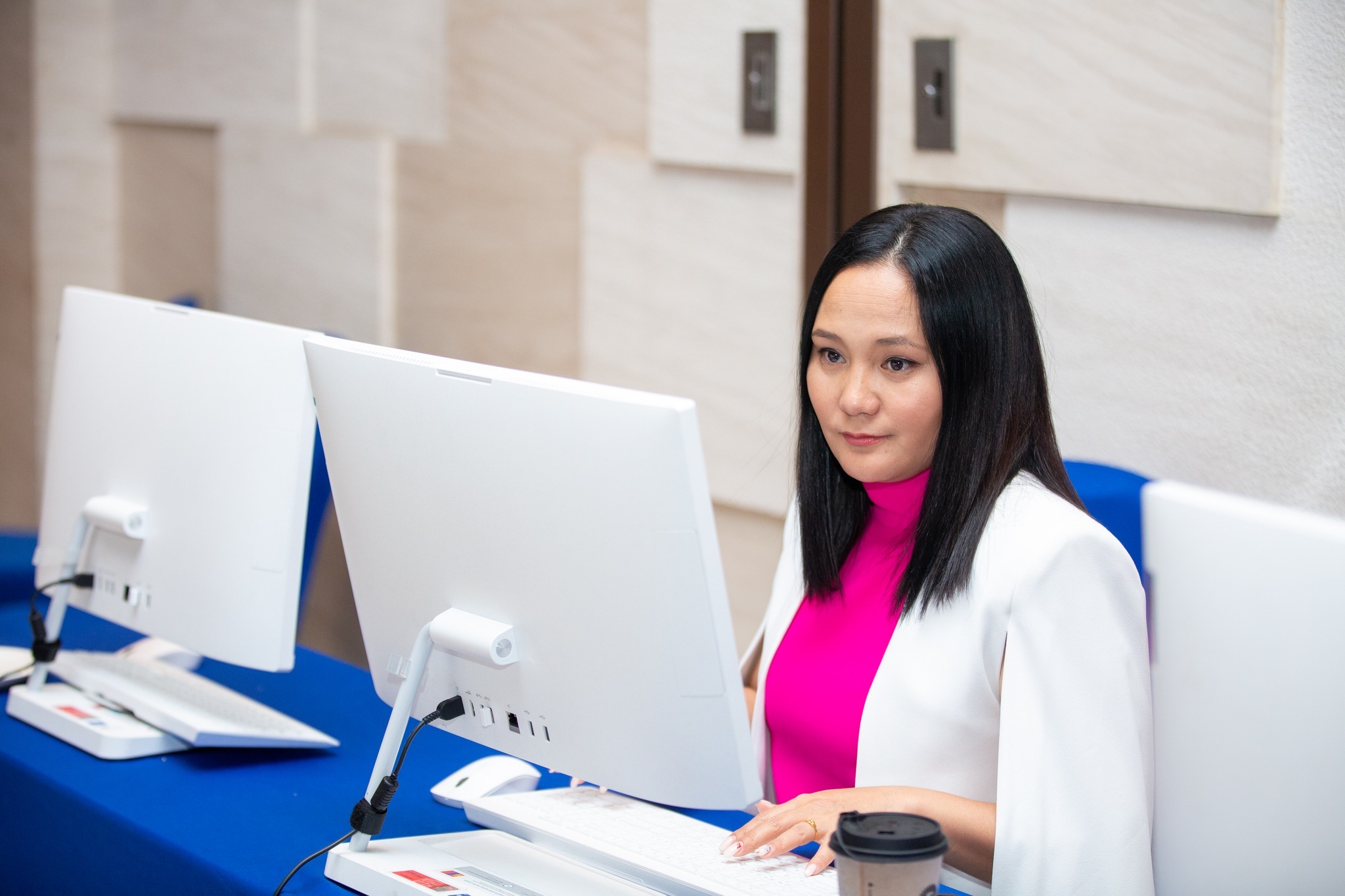Are you a woman rising in your own home, or renting a room someone else has built?
We are pleased to share with our readers a conversation with a distinguished guest in our “Room Guest” column who addresses this question.
We met with N. Enkhsaikhan, Deputy Director of Empasoft Technology School, a dynamic leader driven by the noble goal of nurturing the future generations of our homeland into strong competitors in the field of artificial intelligence. Known as the head of Mongolia’s branch of the “Women In Tech” movement—which has guided thousands of women worldwide to the forefront of modern development—Enkhsaikhan transitioned from journalism and writing into the technology sector.
In this interview, we discussed the role and influence of women in the era of artificial intelligence, which will shape the future of our planet.

— You recently participated in the 4th World “Women In Tech” Summit held in Osaka, Japan. Could you share some insights from the event?
— I attended the 4th “Women In Tech” Summit. This large organization represents over 60 countries, and we have been registered as the 26th country for three years now. Last year, we received the Social and Digital Inclusion Award at the summit held in Paris. The main theme of this year’s “Women In Tech” summit was Women’s Participation in Artificial Intelligence. The event discussed how major global companies are developing AI and to what extent women are involved. It became clear that women are somewhat lagging behind in AI development. Another important topic was the risks of developing this technology without female participation. As a result, we signed the Osaka Protocol during this summit, which accelerates our goal to impact five million girls and women by 2030. Given the significant role women’s use of AI plays in reducing poverty and improving equal access to education, this protocol is very timely.
— What is the current position of women in the field of artificial intelligence?
— Just two days ago, I saw an advertisement created entirely by Tesla’s AI. In it, the teacher in a middle school classroom is a woman, but when the focus shifts to the pilot, the AI automatically chose a father figure. The ad implied that the person who designed the Tesla car and enjoys speed and power is a boy who wishes to be like his father, experiencing the wonders of speed and strength. However, the ad never shows a girl driving a Tesla. This is exactly the issue we are raising. If AI-generated ads do not include girls, young women will not be interested in science and technology fields. The harm is evident — technology and content developed without female involvement tend to become products unfriendly to women.

— Women in this field need to push themselves forward, but often face many obstacles, like illness or childcare responsibilities. Do you think these challenges hinder women from entering the tech sector as actively as men?
— I have been conducting AI training sessions for four months now, with around 500 participants so far. About 30% are women and the rest are men. The men tend to learn very well — when I assign homework, they complete it the same day. They clearly understand the value of their investment and show good results. Meanwhile, many women struggle to attend classes consistently due to the challenges you mentioned. This is a real issue. The training lasts only 20 minutes per day — women could easily listen while washing dishes and then complete tasks on their phones or computers. Although they know the importance of learning and investing in themselves, some don’t fully grasp its value. Most understand that using these tools and technologies can increase their income — creating company posters, reels, websites, etc. Yet, they still find excuses to not dedicate time for themselves. Regardless of whether Mongolians fully understand AI, progress continues. Most students enrolling at Empasoft are brought in by their mothers. The children who succeed tend to be those whose mothers have a strong influence. If we truly want our children and Mongolia’s future to thrive, parents must lead by example. Of course, it takes time, but supporting their children’s growth means women are also developing themselves.
— So, we need to stop seeing technology as something difficult, both for ourselves and for future generations. How can changing this perspective create new opportunities and growth?
— One of the courageous ways women can change themselves is through technology. Among my acquaintances, many women have succeeded in the tech sector. You can earn respect in any environment. However, being respected is closely linked to financial independence. Women who achieve financial freedom tend to lose interest in trivial matters. Knowledge and education are key to reaching financial freedom. When a woman is educated and financially secure, she naturally becomes empowered. But that doesn’t mean blaming the men around her or calling them useless. Men also have their own space, their own “room.” Women need to understand where balance lies — when to open the door to men’s space, and when to support them. That wisdom is crucial.

— What professions or roles in the technology sector give women a unique advantage—fields that only women can excel in?
— Women have a remarkable skill. Imagine a woman holding her child with one arm, a phone wedged between her ear and shoulder, cooking over a hot stove with the other hand, and simultaneously telling her husband where his socks are. Try to have a man do that! He wouldn’t manage holding the child, answering the phone, cooking, and grabbing something from the washing machine all at once. Also, a woman never underfeeds her child, undercooks food, or neglects cleaning the home. This precision and care stem from a woman’s mind, understanding that a healthy and safe family depends on these details. This kind of wisdom and meticulous skill is invaluable to tech companies. After developers finish their coding and system assembly, someone has to oversee incoming customer orders, coordinate with finance and legal teams — that overseeing role is best likened to a woman multitasking like the one holding her child. Coding tasks can be done by men, who usually have the patience to focus on a single task until completion. Many successful projects owe their success to exactly this division of labor.
— You started as a journalist, have written books, and collaborated with the “Princess” center on many projects aimed at girls and young women. No one would have imagined you’d transition into technology, master it, and encourage others with words like “You can code too, Tsogii.” How did that happen?
— I began working as a training manager at a tech company. Organizing things is a natural skill for journalists. However, the biggest initial challenge was the attitude toward a woman managing tech training. When I suggested offering training on open-source systems, I was often met with skepticism: “Do you even understand this training yourself?” That made me work harder. Without understanding coding, programming languages, systems, networks, and cybersecurity, I couldn’t sell the training. So, I spent eight months constantly studying at my desk. I noticed that among those attending training, there were almost no women. There was no learning space for women in tech. That space simply wasn’t offered to them. Company leaders calculated that if they enrolled Boldoo in training, in a couple of years he’d be a senior engineer. But if they tried to enroll Tsetsegee, who went on maternity leave, their investment might not pay off. Thus, Boldoo was chosen. To create a space for Tsetsegee, we had to bring in Alimaa or Sara, who had already found their own place. There’s a saying: “If there’s no chair at the table of success, don’t wait for someone to bring one — drag your own chair and sit down.” To the girls and women reading this: never wait for someone else to give you an opportunity. If there’s no chair, bring your own, because those who create their own opportunities always find a way.
— Many women feel they sacrifice themselves for others and sometimes forget about their own needs. They might feel guilty for trying to do something for themselves. Do you think this mindset affects women’s progress?
— Deciding to become someone’s wife is a major decision; deciding to marry and have children is even bigger. If you want to be one of the two pillars holding up a family, both partners must share responsibilities equally. Let me use myself as an example. I am the director of a tech company, co-founder and deputy director of Empasoft school, Mongolia’s ambassador for “Women In Tech,” and an international coach — but I can’t just avoid washing dishes at home because of these roles. I accept that at home, I am a mother. My husband is a great meditation and yoga instructor, but he doesn’t just sit and watch TV at home. When I’m out empowering thousands of women worldwide, it’s his duty to care for our child. Young couples need to understand this from the start. If you say “You’re a wife, so you must do this” and “I’m a husband, so I must do that,” no one gets to grow. Both husband and wife should develop together. Regardless of who you are, the family should be happy. Leave your social status, honors, and titles at the door, and come home to fulfill your family duties. Allow yourself to enter home with happiness — everything else can stay outside. That’s my rule.
— Our website’s motto is to help women have their own room in the world of success and support their growth. So, where is your “room”?
— I am essentially a digital nomad. I work wherever I want and book flights whenever I feel like it. During those times, my spouse supports me a lot. Even though I can work fully from home, when I’ve been there too long, he says, “Please change your environment — otherwise, our home will turn into Empasoft. You have responsibilities to teach and guide, and if you do that, you’ll impact many women’s lives.” This makes a woman reflect inwardly. I wonder if I’m naturally a caregiver, a giver, a receiver, or just a born mother. My friend Badmaa, founder of “Momade,” is a natural mother and gathers many mothers to run businesses for the good of children. I, however, am not a natural mother. I’m a natural teacher and leader. My room isn’t in my home — sorry — my room is a conference hall, an international meeting stage, or the lounge at an airport. Having found my room, I work without complaints. So, women shouldn’t aspire to be someone else like Enkhsaikhan or anyone else — because their room is elsewhere. Virginia Woolf wrote about women’s space and “a room of one’s own” because her room was her writing. That’s why she left us her great works.

— Let’s talk about “Empasoft” Technology School, which is opening new pathways to promote Mongolian youth globally. How many girls and women are currently studying at your school?
— Empasoft Technology School was established under the umbrella of “Ider” University, and we have just completed our second enrollment, currently operating with 60 students. When we first founded the school, only about 10% of the students were girls; now that number has grown to 30%. Our goal is to increase this to 50%. Last year, we toured 21 provinces and met over 10,000 children and young people. Roughly half of them were girls. We continue working to show that there is no sector where girls cannot succeed.
— Could you share some information about where your Empasoft students are working now?
— Having 60 students now means that in about three years, we expect to have roughly 500 students. In 2024 and 2025, nine students went abroad to study. Two participated in student exchange programs, four joined summer programs, and three will be going to Japan this year for internships. Generally, as soon as our students finish their second year, they start working. They get paid internships under the guise of practical training. This trend is not unique to Empasoft; all schools that offer technology programs now have employers selecting and hiring their students before graduation. I view Mongolia’s future with great optimism and confidence. That same faith is evident in the eyes of parents who entrust their children to our school because technology develops at a rapid pace.
— Thank you for taking the time to speak with us.


